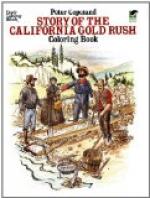While the sequoia gigantea delights in a clear sky and hot sunshine, its brother, the sempervirens, prefers a cool sea-coast climate, offering frequent baths of fog. There is also a difference in the size of these trees; the redwood is often three hundred feet high, but is less in girth than its relative in the Sierras. There is not much underbrush and little sunshine in the cool, green redwood forests, each tree rising tall and stately for a hundred feet without branches, while the green tops seem almost to touch the sky as one looks up. Through the woods one hears the blue jay scream and chatter, and the tap, tap of the woodpecker as he drills holes in the bark to fill with acorns for his winter store.
When the lumberman looks at these beautiful forests, he sees only many logs containing many thousand feet of lumber, which he must get out the easiest and cheapest way. He only chooses the finest and largest trunks, and there is great waste in cutting these. The men begin to saw the tree some eight or ten feet from the ground, and soon it trembles and falls with a mighty crash, often snapping off other trees in its way to the ground. After all the selected trees have fallen, fires are started to burn off the branches and underbrush so that the men can work easier. This fire only chars the outside bark of the big, green logs, but it kills all the young saplings, and leaves the once beautiful forest a waste of blackened logs and gray ashes. When the fire burns itself out, the logs are usually sawed with a cross-cut saw into sixteen-foot lengths, since in that form they are easy to handle. Then oxen or horses haul them out; or sometimes a wire cable is fastened to them by iron “dogs,” or stakes, and a little stationary engine pulls them away to the siding at the railroad track. Here they are rolled on flat-cars, fastened with a big iron chain around the four or six logs on the car, and taken on the logging train to the mill-pond. They lie soaking in the water until drawn up to the keen saws of the sawmill that cut and slice the wood like cheese. The bark and outside is carved off as you would cut the crust off bread, and then sharp, circular saws cut boards and planks till the log is used up, and the log-carriage lifts another to its place. As the shining steel bites into the wood the noise almost deafens you and the mill shakes with the thunder of log-carriage and feeders. Useless ends, slabs, and refuse are burnt in the sawdust pit, where the fires never go out. Very much of the tree is wasted and all the limbs. The redwood tree has so much life and strength, however, that it sends up bright green sprouts around the burnt stump, and standing trees charred outside to the tops will have new branches the next season. In the older forests tall young trees are often seen growing in a ring round an empty spot, the long-dead stump having rotted away.
[Illustration: BIG TREES AT FELTON, SANTA CRUZ CO.]




